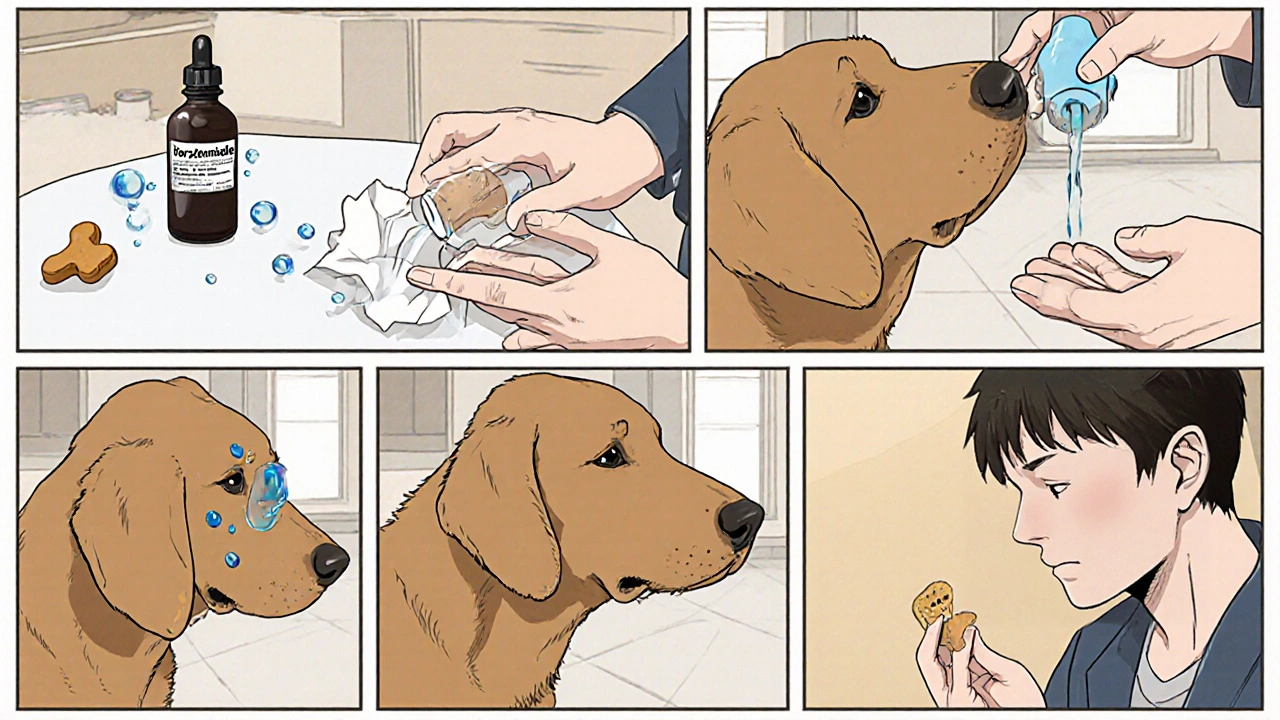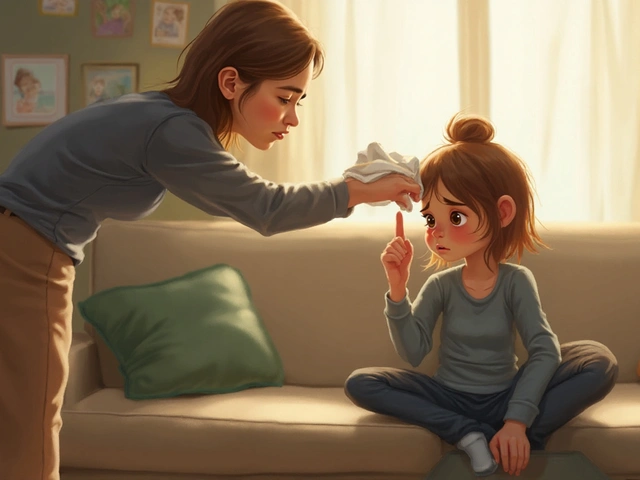Pet Glaucoma Medication Dosage Calculator
Calculate Your Pet's Dorzolamide Dose
Glaucoma can silently steal a pet’s sight, and owners often feel helpless until a vet prescribes a medication they’ve never seen before. dorzolamide is a carbonic anhydrase inhibitor commonly used in human eye drops, but it’s also an effective option for dogs and cats when the vet decides it’s safe. This guide walks you through everything you need to know - from spotting the warning signs to giving the drops without turning the whole process into a circus.
What Is Dorzolamide and How Does It Help Glaucoma?
Dorzolamide is a topical carbonic anhydrase inhibitor that reduces the production of aqueous humor inside the eye, thereby lowering intraocular pressure (IOP). It was first approved for human use in the early 1990s and has since become a staple in many glaucoma treatment plans.
In pets, the same mechanism applies: by slowing fluid buildup, dorzolamide helps protect the optic nerve from the pressure‑induced damage that leads to blindness.
Understanding Glaucoma in Dogs and Cats
Glaucoma in animals isn’t just “high eye pressure.” It’s a complex condition that can be primary (genetic) or secondary (caused by trauma, inflammation, or lens abnormalities). The two most common forms are:
- Primary Open‑Angle Glaucoma (POAG): Often hereditary in certain breeds such as the Beagle, Basset Hound, and Siamese cat.
- Secondary Glaucoma: Usually follows cataract surgery, uveitis, or eye injuries.
Key signs include a cloudy cornea, red eye, dilated pupil, and, in advanced stages, visible optic nerve cupping. If you notice any of these symptoms, schedule a veterinary ophthalmology appointment immediately.
Reading the Prescription: What to Look for on the Bottle
Veterinary eye drops come with a label that may look foreign compared to human medications. Here’s what to decode:
- Concentration: Usually 1% dorzolamide (10 mg/mL). Some formulations are preservative‑free, which is gentler on a pet’s eye.
- Dosage Instructions: The label might say “1 drop per eye BID” (twice daily) or “q12h.” Follow the vet’s written plan, not the human label.
- Expiration Date: Eye drops lose potency after a few weeks once opened. Most vials are good for 28 days after the first use.
If any of these details are missing, call your clinic before you start.

Calculating the Correct Dose for Your Pet
Even though dorzolamide is a drop‑formulation, the actual volume per drop can vary between bottles (typically 0.05 mL per drop). Your vet will prescribe the number of drops based on your pet’s species, weight, and severity of IOP.
| Species | Weight Range | Recommended Dose | Frequency |
|---|---|---|---|
| Dog | 5-15 kg | 1 drop per affected eye | BID |
| Dog | >15 kg | 1-2 drops per affected eye | BID |
| Cat | All sizes | 1 drop per affected eye | BID |
Always double‑check the vet’s written order. If you’re unsure whether to give one or two drops, start with one and watch for any irritation before adding more.
Step‑by‑Step Technique to Administer the Drops
- Gather Supplies: Have the dorzolamide bottle, a clean tissue, and a treat handy for positive reinforcement.
- Wash Your Hands: Even with gloves, a quick hand wash removes oils that could transfer to the eye.
- Position Your Pet: For dogs, a seated or lying‑down position works best. For cats, place them on a stable surface with a towel underneath to prevent slipping.
- Stabilize the Head: Gently hold the top of the head with one hand, using your thumb and forefinger to keep the eyelids open. Avoid touching the cornea.
- Apply the Drop: Hold the bottle upside down, press lightly to release one drop onto the lower fornix (the pocket between the eyelid and the eye). Do not let the tip touch the eye or fur.
- Close the Eye: After the drop, gently close the eyelid for about 20 seconds. This helps spread the medication and reduces drainage through the tear duct.
- Reward: Give a small treat and verbal praise. Positive association makes future dosing easier.
- Repeat if Needed: If you’re giving drops to both eyes or two drops per eye, wait a minute between each application.
Practice makes perfect. If your pet thrashes, take a short break, then try again. For especially skittish cats, a calm carrier environment or a partner to hold them can be a lifesaver.
Monitoring Your Pet After Treatment Begins
Glaucoma management isn’t a “set and forget” job. You’ll need to track a few metrics:
- IOP Checks: Your vet should measure intraocular pressure at least once a week for the first month, then monthly once stable.
- Behavioral Signs: Look for squinting, pawing at the eye, or decreased activity. These could signal pain or side effects.
- Eye Appearance: A clear cornea and normal pupil size indicate good control. Persistent redness or cloudiness needs a vet revisit.
Keep a simple log - date, time of drop, and any observations. Over time, you’ll spot patterns that help you and the vet fine‑tune the regimen.

Potential Side Effects and When to Call the Vet
Most pets tolerate dorzolamide well, but be aware of these red flags:
- Eye Irritation: Redness, burning, or excessive tearing within a few minutes of dosing.
- Systemic Effects: Rarely, pets may experience lethargy, loss of appetite, or mild GI upset if the drug enters the bloodstream in large amounts.
- Allergic Reaction: Swelling of the eyelid, hives, or facial edema. Seek veterinary care immediately.
If any of these symptoms persist beyond 24 hours, contact your clinic. Early intervention prevents permanent damage.
Safety Tips to Minimize Risks
Here are proven habits that keep the treatment safe and effective:
- Use Preservative‑Free Formulations: These reduce the chance of corneal toxicity, especially for pets needing long‑term therapy.
- Store Properly: Keep the bottle in a cool, dark place. Avoid the freezer - it can change the drop size.
- Never Share Medication: Dorzolamide dosed for one species may be too strong or weak for another.
- Watch for Contamination: If the tip touches the eye or fur, replace the dropper tip with a sterile one if available, or discard the bottle after 28 days.
- Combine With Other Medications Carefully: If the vet also prescribes prostaglandin analogues or beta‑blockers, timing matters. Usually, give dorzolamide first, wait five minutes, then apply the next drop.
Following these can dramatically lower the chance of complications and keep your pet’s vision intact.
Frequently Asked Questions
Can I use human Dorzolamide eye drops for my dog?
Only if a veterinarian explicitly approves it. Human formulations often contain preservatives that can irritate a pet’s eye, and the concentration may differ from what the vet prescribed.
How long does it take to see a drop in eye pressure?
Dorzolamide begins lowering IOP within an hour, but measurable changes typically appear after 2‑4 hours. Consistent twice‑daily dosing is needed for long‑term control.
What should I do if I miss a dose?
Give the missed dose as soon as you remember, then continue with the regular schedule. Don’t double‑up doses to catch up.
Can dorzolamide cause systemic side effects in cats?
Systemic absorption is low, but some cats may show mild lethargy or reduced appetite. If these signs persist, have the vet reassess the dosage.
Is it safe to use dorzolamide alongside other glaucoma meds?
Yes, many treatment plans combine dorzolamide with prostaglandin analogues or beta‑blockers. Timing matters - administer dorzolamide first, wait a few minutes, then apply the second medication.
Armed with this knowledge, you can confidently manage your pet’s glaucoma at home while staying in close contact with your veterinary ophthalmologist. The goal is simple: keep the pressure down, the eye comfortable, and the sight intact for as many happy years as possible.






Eli Soler Caralt
Contemplating the silent tyranny of intra‑ocular pressure in our beloved companions evokes a profound metaphor for the unseen burdens we each bear in this fleeting existence. The act of applying a single droplet of dorzolamide becomes a ritual, a tiny benediction that mirrors the philosopher’s quest for equilibrium amidst chaos. One must approach the bottle with reverence, for even the most mundane instrument can become an altar of hope when we acknowledge the fragility of sight. In the dim light of the veterinary clinic, the clinician’s hands become conduits of both science and compassion, translating complex biochemistry into a gentle kiss upon the cornea. Imagine the aqueous humor as a restless tide, threatening to flood the delicate cavern of the eye, and the drop as a dam, a measured restraint against an inevitable surge. This is not merely pharmacology; it is an ode to restraint, an affirmation that we can, in small ways, govern the forces that would otherwise erode our treasured perceptions. Yet, the effectiveness of dorzolamide hinges on a disciplined cadence-twice daily, like the measured breaths of a meditator, aligning body and spirit. Failure to honor this schedule invites the return of pressure, a reminder that neglect is the silent accomplice of disease. As we log each administration, we inscribe a narrative of vigilance, each entry a verse in the epic of caretaking. The pet, oblivious to the minutiae, rewards us with a flicker of comfort, a gentle blink that whispers gratitude. And so, dear reader, let us not reduce this practice to mere routine; let us elevate it to a testament of intentionality, a small yet profound act of love. 🌟🧡
John Price
Indeed, the metaphor captures the urgency.
Erika Thonn
An intrigueing aspect of the guide is the emphasis on preservative‑free formulation, which i think is crucial because pets are more sensetive to chemicals. The table provided is helpful but i would add a note about checking the drop size before dosing. Also, my cat once reacted badly to a human brand, so call the clinic if you see any redness or irritation. Remember that the dose is based on weight so a heavy dog might need two drops, not one. Keep the bottle in a cool place, avoid the freezer, and record each administation in a log. The step‑by‑step list is clear, but balancing a squirming cat may require a towel and a second pair of hands. Finally, do not forget to reward your pet after each dose, it reinforces positive behavior.<\/p>
Jake Hayes
You missed the point: the dosage is non‑negotiable; follow the vet's written plan exactly.
Brandy Eichberger
My dear fellow caretakers, let us celebrate the elegance of this protocol which marries scientific rigor with compassionate stewardship. While the guide is comprehensive, I would stress the importance of observing your pet’s subtle cues-those fleeting glances that betray discomfort. A gentle pat after dosing does more than reward; it reassures the animal that you are a steadfast guardian. Moreover, storing the dorzolamide in a shaded cabinet preserves its potency, a detail sometimes overlooked in hurried households. Should you ever question the regimen, contact your veterinary ophthalmologist promptly; their expertise is the final arbiter of success.<\/p>
Ericka Suarez
We must protect our nation’s pets with fierce loyalty! Dorzolamide is a shield, simple but powerful. Do not let foreign preservatives poison our dogs and cats. Keep the bottle safe, store it right, use it as told. If the eye burns, act fast, call the vet, no hesitation! Our furry friends deserve the best, no compromise!<\/p>
parbat parbatzapada
What they don’t tell you is that the pharmaceutical companies hide the real side effects behind fancy labels. Every drop could be a tiny Trojan horse, silently entering the bloodstream while we think it’s just eye drops. The conspiracies run deep-why are preservative‑free versions so hard to find? It feels like a deliberate scarcity to keep us dependent. Stay vigilant, read the fine print, and don’t trust the glossy packaging. If something feels off, trust your gut, not the marketing.<\/p>
Casey Cloud
Here are a few practical tips you can start using today: always wash your hands before handling the bottle keep the tip above the rim to avoid contamination store the drops in a cool dark place avoid the freezer check the expiration date once opened replace the vial after 28 days if you notice any redness or increased tearing contact your vet immediately. Consistent logging of each dose helps identify patterns and makes follow‑up appointments more productive.<\/p>